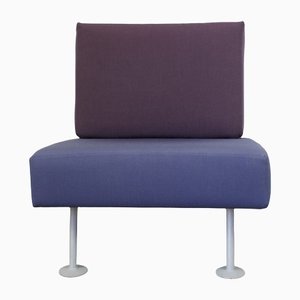
Though he passed away prematurely, in February 2013, at the hands of pneumonia, British product and furniture designer James Irvine endures as a visionary of millennial-era functionalism. Often collaborating with the likes of Jasper Morrison, Marc Newson, Konstantin Grcic, , among others, Irvine blended ergonomics and practicality with wit and style, designing everything from bottle caps to city buses.
Born 1958 in London, Irvine trained first at the Kingston School of Art, and then, at London’s Royal College of Arts—the powerhouse institution that has incubated everyone from Max Lamb, Simon Hasan, and to Committee’s Harry Richardson and Studio Glithero’s Sarah van Gameren. Upon graduating in 1984, the resolutely post-punk Irvine moved permanently to Milan to join in the blossoming postmodern movement. He took a design consultant position at Olivetti—working alongside Memphis pioneers Ettore Sottsass, Michele De Lucchi, and George Sowden’s—before moving on to Toshiba’s design studio, where he proposed highly ergonomic computer designs. By 1989, he was seen as a rising design star in Milan and was invited to design a Pepper Mill for Alessi and taps for Fantini, which bear the flamboyant geometries of the late Memphis years.
Although Olivetti folded under competitive pressures from Epson, Canon, and the like, Irvine remained in partnership with Sottsass well into the millennium; their salient post-Olivetti projects included the establishment of Vitra’s Citizens Office (1991) initiative, which essentially outlined principles for the maximally ergonomic workplace, as well as the multi-hued interior for Milan’s Malpensa airport in 2000.
Irvine also maintained his own studio, which produced the Piceno Collection for Cappellini in 1991; this vividly-painted beechwood furniture series—including a chair, a coatrack, and tables—appropriated traditional silhouettes alongside eccentric curves, evincing the liminal stage Irvine found himself after the 1980s: somewhere between postmodern ostentation and the elegant resolve of his later work.
At the turn of the millennium, Irvine remained prolific. Some of his most enduring designs from this era are the Lunar Sofa for B&B Italia / C&B Italia (1998), the X5 Rug for Asplund (1999), and the Centomila Chairs for Magis (1999). In 1999, he procured a substantial commission from the city of Hannover to head up a full re-design of their bus fleet, to be manufactured by Mercedes-Benz. From then on, he continued to design a variety of goods at all scales, conceptual and practical, for luxury and economy brands, for example his Float Circle Light for Artemide (2000), rattan Gunghult Rocker for Ikea (2002), his Lounge Chair for WMF (2006)—before delving, in 2007, into an art directorship at Thonet, for whom he designed his innovative Loop Chair in 2004. During this tenure, Irvine introduced Thonet to Muji—for whom Irvine had also designed—and the two brands collaborated in 2009 on streamlined updates to Thonet’s traditional forms of tubular steel and bentwood furniture.



